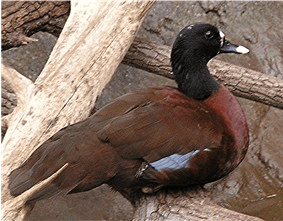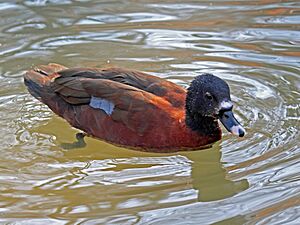Hartlaub's duck facts for kids
Quick facts for kids Hartlaub's duck |
|
|---|---|
 |
|
| Conservation status | |
| Scientific classification | |
| Genus: |
Pteronetta
|
| Species: |
hartlaubii
|
The Hartlaub's duck (scientific name: Pteronetta hartlaubii) is a dark, reddish-brown duck. It lives in the forests of Africa. This duck is quite unique. Scientists used to group it with "perching ducks" or "dabbling ducks." Now, they place it in its own special genus called Pteronetta. This shows how different it is from other ducks.
Scientists have studied its DNA. They think the Hartlaub's duck might be related to the blue-winged goose. Both are African water birds with unique family trees.
Contents
What Does a Hartlaub's Duck Look Like?
Hartlaub's ducks are about 56 to 58 centimeters (22-23 inches) tall. This species is monotypic. This means there is only one type of Hartlaub's duck.
Young ducks have pale tips on their chest feathers. Their adult feathers grow in after about six months. Adult males weigh between 925 and 1140 grams (about 2-2.5 pounds). They have a white head and reddish-brown eyes.
Female ducks weigh less, about 770 to 805 grams (about 1.7-1.8 pounds). They have very little white on their heads. Their eyes are dark red. The amount of white on a duck's head can be different for each bird.
Both male and female ducks have a blue patch on their wings. This helps tell them apart from other water birds. During mating season, the base of the male's bill gets bigger.
Where Do Hartlaub's Ducks Live?
Hartlaub's ducks live in equatorial West and Central Africa. You can find them from Guinea and Sierra Leone in the west. Their range goes east through Nigeria to South Sudan. It also extends south to Gabon, Congo, and Zaire.
This bird is named after a German naturalist named Gustav Hartlaub.
Hartlaub's ducks live in many wet places. These include swampy marshes, tropical forests, and savanna areas. They also live near rivers and streams. In Liberia, they live in mangrove swamps. They only gather in flocks in Liberia from January to May. They live year-round in parts of central western Africa. This includes the Democratic Republic of Congo and Cameroon.
How Do Hartlaub's Ducks Behave?
When flying, Hartlaub's ducks make a "ko-ko-ko-ko" or "kakakakarr" sound. Their everyday sounds are "whit-whit-whit." If a male feels threatened, it will make a fast, "wheezy whistle" quack. Young ducks in trouble make three quick, descending calls.
Their diet includes small water animals. They eat insects and crustaceans. In the Republic of Congo, they eat insects found in elephant dung. They also eat seeds and insect larvae.
These ducks have a special way to clean themselves. They jump onto the backs of large animals. These include bongo and forest buffalo. They do this to remove tiny bugs called ectoparasites. Hartlaub's ducks are most active in the early morning and evening.
Reproduction
Scientists have not found many Hartlaub's duck nests. However, they know these ducks mate during the rainy season. This is usually from June to September.
Female ducks lay cream-colored eggs. When the chicks hatch, they have sooty-black heads. Their bodies are yellowish. They also have an orange tint on their chin, neck, and face. These chicks weigh about 35 to 46 grams (about 1.2-1.6 ounces) when they hatch.
Population Status
The Hartlaub's duck lives in a very large area. Because of this, it is not considered vulnerable. Its population size is also stable. Even though the number of ducks might be slowly going down, it's not happening fast enough to be a worry.
The population size is not too small. This means the species is not at risk of disappearing. For these reasons, the Hartlaub's duck is listed as "Least Concern." This means it is not currently threatened.
Conservation Efforts
In 2006, there were an estimated 26,000 to 110,000 Hartlaub's ducks in the world. They were once thought to be threatened. However, as of 2020, they are no longer considered threatened.
The biggest dangers to Hartlaub's ducks are:
- Forest destruction
- Hunting
- Water pollution from mining
- Poison-fishing
In Nigeria, people hunt and trade this species. They use the ducks for traditional medicinal purposes.



